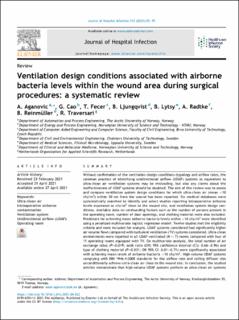| dc.contributor.author | Aganovic, Amar | |
| dc.contributor.author | Cao, Guangyu | |
| dc.contributor.author | Fečer, Tomáš | |
| dc.contributor.author | Ljungqvist, Bengt L. | |
| dc.contributor.author | Lytsy, Birgitta | |
| dc.contributor.author | Radtke, Andreas | |
| dc.contributor.author | Reinmüller, Berit | |
| dc.contributor.author | Traversari, Roberto A.A.L. | |
| dc.date.accessioned | 2021-09-15T07:38:53Z | |
| dc.date.available | 2021-09-15T07:38:53Z | |
| dc.date.created | 2021-06-19T12:53:26Z | |
| dc.date.issued | 2021 | |
| dc.identifier.citation | Journal of Hospital Infection. 2021, 113, 85-95. | en_US |
| dc.identifier.issn | 0195-6701 | |
| dc.identifier.uri | https://hdl.handle.net/11250/2777311 | |
| dc.description.abstract | Background
Without confirmation of the ventilation design conditions (typology and airflow rate), the common practice of identifying unidirectional airflow (UDAF) systems as equivalent to ultra-clean air ventilation systems may be misleading, but also any claims about the ineffectiveness of UDAF systems should be doubted. The aim of this review was to assess and compare ventilation system design conditions for which ultra-clean air (mean <10 cfu/m3) within 50 cm from the wound has been reported. Six medical databases were systematically searched to identify and select studies reporting intraoperative airborne levels expressed as cfu/m3 close to the wound site, and ventilation system design conditions. Available data on confounding factors such as the number of persons present in the operating room, number of door openings, and clothing material were also included. Predictors for achieving mean airborne bacteria levels within <10 cfu/m3 were identified using a penalized multivariate logistic regression model. Twelve studies met the eligibility criteria and were included for analysis. UDAF systems considered had significantly higher air volume flows compared with turbulent ventilation (TV) systems considered. Ultra-clean environments were reported in all UDAF-ventilated (N = 7) rooms compared with four of 11 operating rooms equipped with TV. On multivariate analysis, the total number of air exchange rates (P=0.019; odds ratio (OR) 95% confidence interval (CI): 0.66–0.96) and type of clothing material (P=0.031; OR 95% CI: 0.01–0.71) were significantly associated with achieving mean levels of airborne bacteria <10 cfu/m3. High-volume UDAF systems complying with DIN 1946-4:2008 standards for the airflow rate and ceiling diffuser size unconditionally achieve ultra-clean air close to the wound site. In conclusion, the studied articles demonstrate that high-volume UDAF systems perform as ultra-clean air systems and are superior to TV systems in reducing airborne bacteria levels close to the wound site. | en_US |
| dc.language.iso | eng | en_US |
| dc.publisher | Elsevier Science | en_US |
| dc.rights | Navngivelse 4.0 Internasjonal | * |
| dc.rights.uri | http://creativecommons.org/licenses/by/4.0/deed.no | * |
| dc.title | Ventilation design conditions associated with airborne bacteria levels within the wound area during surgical procedures: a systematic review | en_US |
| dc.type | Peer reviewed | en_US |
| dc.type | Journal article | en_US |
| dc.description.version | publishedVersion | en_US |
| dc.source.pagenumber | 85-95 | en_US |
| dc.source.volume | 113 | en_US |
| dc.source.journal | Journal of Hospital Infection | en_US |
| dc.identifier.doi | 10.1016/j.jhin.2021.04.022 | |
| dc.identifier.cristin | 1916924 | |
| dc.description.localcode | This is an open access article distributed under the terms of the Creative Commons CC-BY license, which permits unrestricted use, distribution, and reproduction in any medium, provided the original work is properly cited. | en_US |
| cristin.ispublished | true | |
| cristin.fulltext | original | |
| cristin.qualitycode | 1 | |

